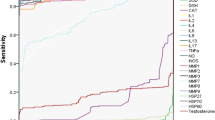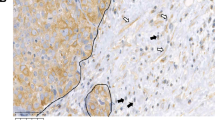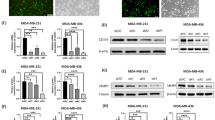Abstract
Matrix metalloprotease-9 (MMP-9; 92 kDa type IV collaganase, gelatinase B) is regarded as, important for degradation of the basement membrane and extracellular matrix during cancer invasion and other tissue-remodelling events. In this study we evaluate the prognostic value of MMP-9, by immunoperoxidase staining in a series of 210 breast cancer tissues. The results were quantitated using the HSCORE system, which consider both staining intensity and the percentage of cells stained at given intensities. MMP-9 status was compared with the concentration of cytosolic Cathepsin-D and with other established prognostic factors, in terms of disease free survival and overall survival. The median follow-up period was 62 months. MMP-9 staining was observed primarily in cancer cells, and to a lesser degree in surrounding stromal cells. MMP-9 expression was not detected in normal breast tissue. Levels of MMP-9 expression below the cut-off point were more frequently observed in larger (P=0.014), invasive ductal histologic (P=0.037), progesterone receptor (PR)-negative and PR-strong positive tumours (P< 0.001), as well as samples belonging to patients with stage III-IV disease (P=0.009) and age 45–55 years (P=0.011). In univariate analysis, node-negative breast cancer patients with tumors positive for MMP-9 had a considerable reduction in risk for relapse (RR=0.45; P=0.039) or death (RR=0.32; P=0.009). Multivariate analysis indicated that MMP-9 status was an independent favourable predictor of OS (RR=0.47; P=0.034) in node-negative but not in node-positive patients. Our results suggest that MMP-9 may be an independent favourable prognostic factor in node-negative breast cancer patients. The overexpression of MMP-9 in breast cancer may be also used as a marker to subdivide node negative breast cancer patients in order to determine the optimal treatment modality. © 2001 Cancer Research Campaign http://www.bjcancer.com
Similar content being viewed by others
Article PDF
Change history
16 November 2011
This paper was modified 12 months after initial publication to switch to Creative Commons licence terms, as noted at publication
References
Ardavanis A, Scorilas A, Amanatidou A, Gerakini F, Missitzis I, Garoufali A, Pissakas G, Pateras C, Apostolikas N, Rigatos G and Yiotis I (1997) Cathepsin-D concentration in tumour cytosols improves the accuracy of prognostic evaluation of primary breast cancer. Anticancer Res 17: 1405–1410
Bajou K, Noel A, Gerard RD, Masson V, Brunner N, Holst-Hansen Skobe M, Fusenig NE, Carmeliet P, Collen D and Foidart JM (1998) Absence of host plasminogen activator inhibitor 1 prevents cancer invasion and vascularization. Nat Med 8: 923–928
Benaud CH, Dickson RB and Thompson EW (1998) Roles of the matrix metalloproteinases in mammary gland development and cancer. Br Cancer Res Treat 50: 97–116
Bianchi E, Cohen RL, Dai A, Thor AT, Shuman MA and Smith HS (1995) Immunohistochemical localization of the plasminogen activator inhibitor-1 in breast cancer. Int J Cancer 60: 597–603
Blavier L and DeClerck YA (1997) Tissue inhibitor of metalloproteinases-2 is expressed in the interstitial matrix in adult mouse organs and during embryonic development. Molecular Biology of the Cell 8: 1513–1527
Bruner KL, Rodgers WH, Gold LI, Korc M, Hargrove JT, Matrisian LM and Osteen KG (1995) Transforming growth factor-b mediates the progesterone suppression of an epithelial metalloproteinase by adjacent stroma in the human endometrium. Proc Natl Acad Sci USA 92: 7362–7366
Chambers AF and Matrisian LM (1997) Changing views of the role of matrix metalloproteinases in metastasis. J Natl Cancer Inst 89: 1260–1270
Daidone MG, Silverstrini R, D'Errico A, Di Fronza G, Benini E, Mancini A, Garbisa S Liotta L and Grigioni W (1991) Laminin receptors, collagenase IV and prognosis in node negative breast cancers. Int J Cancer 48: 529–532
Dano K, Behrendt N, Brunner N, Ellis V, Plong M and Pyke C (1994) The urokinase receptor: protein structure and the role in plasminogen activation and cancer invasion. Fibrinolysis 8: 189–203
Doussal VL, Tubiana-Hulin M, Friedman S, Hacerne K, Spyratos F and Brunet M (1989) Prognostic value of histologic grade nuclear components of Scarff-Bloom-Richardson (SBR): an improved score modification based on a multivariate analysis of 1262 invasive ductal breast carcinomas. Cancer 64: 1914–1922
Duffy MJ, Blaser J, Duggan C, McDermott E, O'Higgins N, Fennelly JJ and Tschesche H (1995) Assay of matrix metalloproteinases types 8 and 9 by ELISA in human breast cancer. Br J Cancer 71: 1025–1028
Elashry-Stowers D, Zava D, Speers W and Edwards D (1988) Immunochytochemical localization of progesterone receptors in breast cancer with antihuman receptor monoclonal antibodies. Cancer Res 48: 6462–6474
Friedman R, Toth M and Pena D Mobashery (1995) Activation of progelatinase B (MMP-9) by gelatinase A (MMP-2). Cancer Res 55: 2548–2555
Garbett EA, Reed MWR and Brown NJ (1999) Proteolysis in human breast and colorectal cancer. Br J Cancer 81: 287–293
Hanemaaijer R, Sier C, Visser H, Scholte L, van Lent N, Toet K, Hoekman K and Verheijen J (1999) MMP-9 activity in urine from patients with various tumors, as measured by a novel MMP activity assay modified urokinase as a substrate. Ann NY Acad Sci 878: 141–149
Heppner K, Matrisian L, Jensen R and Rodgers W (1996) Expression of most matrix metalloproteinase family members in breast cancer represents a tumor-induced host response. Am J Pathol 149: 273–282
Hewitt RE and Dano K (1996) Stromal cell expression of components of matrix degrading protease systems in human cancer. Enzyme Protein 49: 163–173
Jonat C, Rahmsdort HJ, Park K, Cato ACB, Gebel S, Ponta H and Herrlich P (1990) Anti-tumor promotion and anti-inflammation: down-modulation of AP-I (Fos/Jun) activity by glycocorticoid hormone. Cell 62: 1189–1204
Jones J, Glynn P and Walker R (1999) Expression of MMP-2 and MMP-9, their inhibitors and the activator MT1-MMP in primary breast carcinomas. J Pathol 189: 161–168
Kaplan EL and Meier P (1958) Nonparametric estimation from incomplete observations. J Am Stat Assoc 53: 457–481
Karameris A, Panagou P, Tsilalis T and Bouros D (1997) Association of expression of metalloproteinases and their inhibitors with the metastatic potential of squamous-cell lung carcinomas. A molecular and immunohistochemical study. Am J Respir Crit Care Med 156: 1930–1936
Kute TE, Hushe MS and Phyme AC (1980) Improvements in steroid receptor assays including rapid computer analysis of data. Anal Biochem 103: 272–279
Liotta LA and Stetler-Steverson G (1991) Tumor invasion and metastasis: An imbalance of positive and negative regulation. Cancer Res 51: 5054–5059
Magklara A, Scorilas A, Stephan C, Kristiansen G, Hauptmann S, Jung K and Diamandis EP (2000) Down-regulation of prostate specific antigen (PSA) and human glandular kallikrein 2 (hK2) in malignant vs non-malignant prostatic tissue. Urology 56: 527–532
Mira E, Manes S, Lacalle RA, Marquer G and Mortinez C (1999) Insulin-like growth factor-1 triggered cell migration and invasion are mediated by matrix metalloproteinase-9. Endocrinology 140: 1657–1664
Nelson A, Fingleton B, Rothenberg M and Matrisian L (2000) Matrix metalloproteinase: Biologic activity and clinical implications. J Clin Oncol 18: 1135–1149
Nielsen BS, Timshel S, Kjeldsen L, Sehested Pyke C, Borregaard N and Dano K (1996a) 92 kDa type IV collagenase (MMP-9) is expressed in neutrophils and macrophages but not in malignant epithelial cells in human colon cancer. Int J Cancer 65: 57–62
Nielsen BS, Sehesed M, Timshel S, Pyke C and Dano K (1996b) Messenger RNA for urokinase plasminogen activator (uPA) is expressed in myofibroblasts adjacent to cancer cells in human breast cancer. Lab Investigations 74: 168–177
Nielsen BS, Sehested M, Kjeldsen L, Borregaard N, Rygaard J and Danon K (1997) Expression of matrix metalloprotease-9 in vascular pericytes in human breast cancer. Lab Investigation 77: 345–355
Pacheco MM, Mourao M, Edson BM, Nishimoto IN and Brentani MM (1998) Expression of gelatinases A and B, stromelysin-3 and matrilysin genes in breast carcinomas: clinico-pathological correlations. Clin Exp Metastasis 16: 577–585
Ree AH, Bjørnland K, Brünner N, Johansen HT, Pedersen KB, Aasen AO and Fodstad O (1998) Regulation of tissue-degrading factors and in vitro invasiveness in progression of breast cancer cells. Clin Exp Metastasis 16: 205–215
Remacle AG, Noël A, Duggan C, McDermott E, O'Higgins N, Foidart JM and Duffy MJ (1998) Assay of matrix metalloproteinases types 1,2,3 and 9 in breast cancer. Br J Cancer 77: 926–931
Rha SY, Kim JH, Roh JK, Lee KS, Min JS, Kim BS and Chung HC (1997) Sequential production and activation of matrix-metalloproteinase-9 (MMP-9) with breast cancer progression. Br Cancer Res Treatment 43: 175–181
Rha SY, Yang WI, Kim JH, Roh JK, Min JS, Lee KS, Kim BS and Chung HC (1998) Different expression patterns of MMP-2 and MMP-9 in breast cancer. Oncol Rep 5: 875–879
Salamonsen LA, Butt AR, Hammond R, Garcia S and Zhang J (1997) Production of endometrial matrix metalloproteinases, but not their tissue inhibitors are modulated by progesterone withdrawal in an in vitro model for menstruation. J Clin Endocrinol Metab 78: 1409–1415
Scorilas A, Yotis J, Gouriotis D, Keramopoulos A, Ampela K, Trangas T and Talieri M (1993) Cathepsin-D and c-erbB-2 have an additive prognostic value for breast cancer patients. Anticancer Res 13: 1895–1900
Scorilas A, Yotis J, Stravolemos K, Gouriotis D, Keramopoulos A, Ampela K, Talieri M and Trangas T (1995) c-erB-2 overexpression may be used as an independent prognostic factor for breast cancer patients. Anticancer Res 15: 1543–1548
Scorilas A, Yotis J, Pateras CH, Trangas TH and Talieri M (1999a) Predictive value of c-erbB-2 and Cathepsin-D for Greek breast cancer patients using univariate and multivariate analysis. Clin Cancer Res 5: 815–821
Scorilas A, Trangas TH, Yotis J, Pateras CH and Talieri M (1999b) Determination of c-myc amplifications and overexpression in breast cancer patients. Evaluation of its prognostic value against c-erbB-2, cathepsin-D and clinicopathologic characteristics using univariate and multivariate analysis. Br J Cancer 81: 1385–1391
Scorilas A, Diamandis E, Levesque M, Papanastasiou-Diamandis A, Khoszavi M, Giai M, Ponzone R, Roagua R, Sismondi P and López-Otin C (1999c) Immuno-enzymatically determined pepsinogen C concentration in breast tumor cytosols: An independent favorable prognostic factor in node-positive patients. Clin Cancer Res 5: 1778–1785
Scorilas A, Talieri M, Ardavanis A, Courtis N, Yotis J, Dimitriadis E, Tsiapalis C and Trangas T (2000a) Polyadenylate polymerase enzymatic activity in mammary tumor cytosols: A new independent prognostic marker in primary breast cancer. Cancer Res 60: 5427–5433
Scorilas A, Black M, Talieri M and Diamandis E (2000b) Genomic organization, physical mapping and expression analysis of the human protein arginine methyltransferase 1 gene. Biochem Biophys Res Commun 278: 349–359
Spiessl B, Beahrs OH, Hermanek P, Hutter RVP, Scheibe O, Sobin LH and Wagner G (1989) Illustrated guide to the TNM/p TNM classification of malignant tumours. TNM Atlas, 3rd edn
Strongin AY, Collier I, Bannikov G, Marmer BL, Grant GA and Goldberg GI (1995) Mechanisms of cell surface activation of 72-kDa type IV collagenase. J Biol Chem 270: 1–8
Sugiura Y, Shimada H, Seeger R, Lang W and Declerck YA (1998) Matrix metalloproteinases-2 and -9 are expressed in human neuroblastoma: Contribution of stromal cells to their production and correlation with metastasis. Cancer Res 58: 2209–2216
Takeha S, Fujiyama Y, Bamda T, Sorsa T, Nagura H and Ohtani H (1997) Stromal expression of MMP-9 and urokinase receptor is inversely associated with liver metastasis and with infiltrating growth in human colorectal cancer: A novel approach from immune/inflammatory aspect. Jpn J Cancer 88: 72–81
Thorpe SM, Christensen IJ, Rasmussen BB and Rose C (1993) Short recurrence-free survival associated with high oestrogen receptor levels in the natural history of postmenopausal primary breast cancer. Eur J Cancer 29A: 971–977
Tryggvason K, Hoyhtya M and Pyke C (1993) Type IV collagenase in invasive tumors. Br Cancer Res Treat 24: 209–218
Visscher DW, Hoyhtya M, Ottosen SK, Liang C-M, Sarkar FH, Crissman JD and Fridman R (1994) Enhanced expression of tissue inhibitor of metalloproteinase-2 (TIMP-2) in the stroma of breast carcinomas correlates with tumor recurrence. Int J Cancer 59: 339–344
Vizoso F, Sanchez LM, Diez-Itza I, Merino AM and Lopez-Otin C (1995) Pepsinogen C is a new prognostic marker in primary breast cancer. J Clin Oncol 13: 54–61
Vu TH and Werb Z (1998) Gelatinase B Structure, regulation and function. In: Matrix metalloproteinases, Parks W C Mecham R P (eds) pp 115–148. Academic Press: San Diego, CA
Yan S, Sameni M and Sloane BF (1998) Cathepsin B and human tumor progression. Biol Chem 379: 113–123
Yousef GM, Scorilas A and Diamandis EP (2000) Genomic organization, mapping, tissue expression and hormonal regulation of trypsin-like serine protease (TLSP PRSS20), a new member of the human kallikrein gene family. Genomics 63: 88–96
Yousef G, Scorilas A, Jung K, Aschworth L and Diamandis EP (2001) The new human kallikrein gene KLK15 is up-regulated in prostate cancer. J Biol Chem 276: 53–61
Yu H, Levesque MA, Clark GM and Diamandis EP (1998) Prognostic value of prostate-specific antigen for women with breast cancer: a large United States cohort study. Clin Cancer Res 4: 1489–1497
Yu Q and Stamenkovic (1999) Localization of matrix metalloproteinase 9 to the cell surface provides a mechanism for CD44-mediated tumor invation. Genes Dev 13: 35–48
Zucker S, Hymowitz M, Conner C, Zarrabi H, Hurewitz A, Matrisian L, Boyd D, Nicolson G and Montana S (1999) Measurement of matrix metalloproteinases and tissue inhibitors of metalloproteinases in blood and tissues. Ann NY Acad Sci 878: 212–227
Author information
Authors and Affiliations
Rights and permissions
From twelve months after its original publication, this work is licensed under the Creative Commons Attribution-NonCommercial-Share Alike 3.0 Unported License. To view a copy of this license, visit http://creativecommons.org/licenses/by-nc-sa/3.0/
About this article
Cite this article
Scorilas, A., Karameris, A., Arnogiannaki, N. et al. Overexpression of matrix-metalloproteinase-9 in human breast cancer: a potential favourable indicator in node-negative patients. Br J Cancer 84, 1488–1496 (2001). https://doi.org/10.1054/bjoc.2001.1810
Received:
Revised:
Accepted:
Published:
Issue date:
DOI: https://doi.org/10.1054/bjoc.2001.1810
Keywords
This article is cited by
-
Quantifiable peptide library bridges the gap for proteomics based biomarker discovery and validation on breast cancer
Scientific Reports (2023)
-
A Phage Display Derived Cyclized Peptide Inhibits Fibrosarcoma Cells Invasion via Suppression of MMP-9 Activity
International Journal of Peptide Research and Therapeutics (2022)
-
Prognostic values of tumoral MMP2 and MMP9 overexpression in breast cancer: a systematic review and meta-analysis
BMC Cancer (2021)
-
Euphorbia humifusa Willd exerts inhibition of breast cancer cell invasion and metastasis through inhibition of TNFα-induced MMP-9 expression
BMC Complementary and Alternative Medicine (2016)
-
Association of Fascin and matrix metalloproteinase-9 expression with poor prognostic parameters in breast carcinoma of Egyptian women
Diagnostic Pathology (2014)



